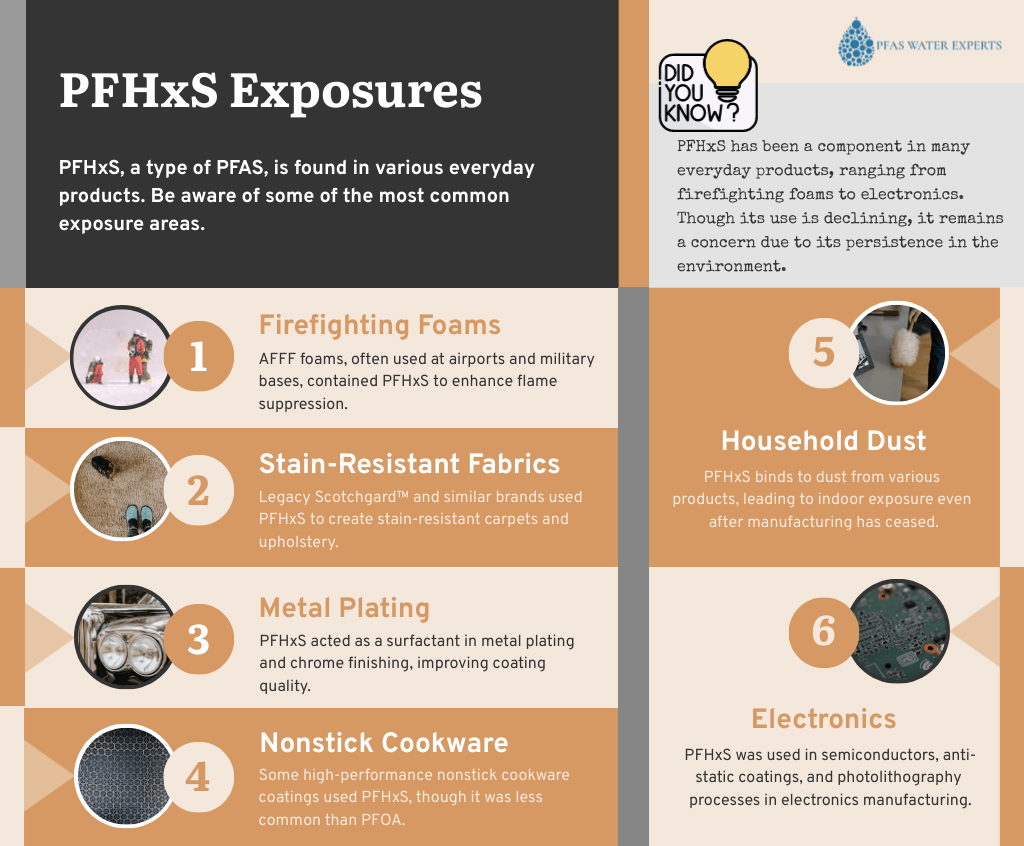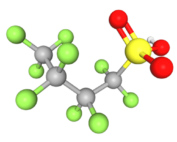Introduction
Perfluorohexane sulfonic acid (PFHxS) is a lesser-known but highly concerning member of the PFAS (per- and polyfluoroalkyl substances) family. While much attention has focused on PFOA and PFOS, PFHxS poses equally serious risks—particularly because of its unusually long half-life in the human body and its role in firefighting foam formulations.
PFHxS is a long-chain PFAS but shorter than PFOA and PFOS. Despite its shorter carbon chain (six perfluorinated carbon atoms), PFHxS persists longer in the human body than PFOS or PFOA, and has been widely detected in blood serum, drinking water, and dust samples. Its sulfonic acid group gives it unique physical and chemical properties that differentiate it from other PFAS and help explain its use in specific industrial contexts.
What Is PFHxS and Why Was It Used?
PFHxS is a six-carbon sulfonic acid PFAS compound. Compared to longer-chain compounds like PFOS (eight-carbon sulfonic acid) or PFNA (nine-carbon carboxylic acid), PFHxS provides a balance of chemical durability, high surfactant efficiency, and resistance to thermal and chemical degradation.
Because of its specific properties, PFHxS was used extensively in:
- Firefighting foams (AFFF): PFHxS was commonly added to AFFF formulations to enhance and speed up film formation and fuel repellency, especially for hydrocarbon fires.
- Electronics manufacturing: PFHxS served as a wetting agent and anti-static additive in semiconductor fabrication, photoresist processing, and circuit board treatments.
- Textile and leather treatments: Due to its strong bonding with fabrics, PFHxS was included in stain- and water-resistant sprays and coatings.
- Metal plating operations: PFHxS provided a surfactant function during chromium electroplating, helping to suppress mist and improve coating uniformity.
Its sulfonic acid group made it a better surfactant than carboxylic acid PFAS like PFOA, and its chemical stability enabled it to perform well under harsh industrial conditions.
How PFHxS Differs from Other PFAS
While PFOA, PFOS, and PFNA are also persistent and bioaccumulative, PFHxS has distinct traits:
- Higher protein affinity: PFHxS binds strongly to albumin and other blood proteins, leading to a longer half-life in humans (7.3 years) than PFOA (2.3 years) or PFOS (5.4 years).
- Smaller molecular size: Its six-carbon backbone allows it to travel more readily in groundwater, increasing the risk of widespread environmental dispersion.
- Lower volatility and higher water solubility, making it both more mobile and more persistent in aquatic environments.
PFHxS Contamination Hotspots
PFHxS contamination has been documented across a variety of settings, often in conjunction with the historical use of AFFF and PFAS-based consumer goods:
- Military bases and training installations: Hundreds of US military bases have reported extensive PFHxS contamination in on-base monitoring wells and nearby groundwater. In some cases, PFHxS was the dominant PFAS detected, suggesting specific AFFF formulations used at those sites may have had disproportionately high PFHxS content.
- Public water supplies near industrial zones: In states like California (notably near Sacramento and the Central Valley), Vermont, and Michigan, PFHxS has been found in municipal drinking water systems downstream from historic AFFF disposal or fluorochemical discharge sites. PFHxS’s high solubility allows it to migrate further from point sources than heavier PFAS.
- Homes with older carpets and stain-proof treatments: PFHxS has been detected in household dust, particularly in residences with legacy carpets and furniture treated with Scotchgard-type products made before 2003. A 2020 study found PFHxS concentrations in dust from such homes were among the highest PFAS detected, posing a chronic low-level exposure route for children.
- Occupational exposure in firefighters and military personnel: Multiple biomonitoring studies show that career firefighters and individuals involved in foam deployment or maintenance show PFHxS blood concentrations 3–10 times higher than the general population. This exposure may result from dermal absorption, aerosol inhalation, and contaminated gear, not just incidental ingestion.
These findings demonstrate that PFHxS exposure can result from both legacy contamination and ongoing occupational contact, underscoring the need for widespread biomonitoring and site cleanup.

Health Risks from PFHxS Exposure
🧪 Altered Hormonal and Reproductive Signaling
Recent toxicological assessments have linked PFHxS exposure to disrupted reproductive signaling pathways, particularly involving estrogen and androgen receptors. A study by Liu et al. (2020) demonstrated that PFHxS interfered with estrogen receptor activity in rat ovarian cells, leading to delayed puberty and abnormal hormone signaling.
A separate review by the National Academies of Sciences, Engineering, and Medicine (2022) reinforced these findings, highlighting PFHxS among PFAS compounds that exhibit hormone-disrupting properties during puberty and fetal development.
🧬 Molecular and Cellular Damage
Oxidative stress and mitochondrial damage were observed in hepatocytes exposed to PFHxS in an in vitro study by Wang et al. (2021), showing increased ROS production and suppression of antioxidant enzymes like SOD and CAT.
These cellular effects are consistent with mechanisms described by the Agency for Toxic Substances and Disease Registry (ATSDR), which links PFHxS to potential liver injury and altered redox balance.
🧠 Cognitive and Behavioral Disruption
Research from a NIEHS-funded study (2022) found that PFHxS-exposed mice exhibited reduced memory and learning abilities, and children with higher PFHxS serum levels in a cohort study performed worse on attention and executive function tests.
These results align with a broader literature review by Grandjean and Budtz-Jørgensen (2019), which associated PFHxS and related PFAS with neurodevelopmental delays and reduced IQ.
🩸 Hematological and Cardiovascular Effects
A cross-sectional analysis from the Korean NHANES study (2019) showed PFHxS was associated with increased systolic blood pressure and altered hematological markers such as hematocrit and platelet count.
Furthermore, elevated PFHxS serum levels have been associated with increased blood pressure and altered endothelial markers, indicating potential cardiovascular strain with chronic exposure.
⚠️ Emerging Cancer Pathways
While PFHxS is not officially listed as a human carcinogen, in vitro studies show it activates cell proliferation signals and modulates gene expression tied to tumor progression, including c-myc, cyclin D1, and Bcl-2. Liver-focused studies show early-stage cellular changes consistent with precancerous transformation, warranting further investigation.
Ongoing studies from the National Toxicology Program and IARC are evaluating PFHxS for potential carcinogenicity, given its mechanistic similarity to PFOA and PFOS.
Regulatory Action and Legal Status
- EPA: In 2023, PFHxS was included in the EPA’s draft Maximum Contaminant Level (MCL) proposal as part of a PFAS group hazard index.
- International treaties: In 2022, PFHxS was added to the Stockholm Convention on Persistent Organic Pollutants, signaling global consensus on its hazards.
- States like California, Michigan, and Vermont have issued health-based advisory limits or MCLs specifically for PFHxS in water.
AFFF Lawsuit: Legal Options for Exposure Victims
Individuals who lived or worked near contaminated military bases or fire training facilities may have been unknowingly exposed to PFHxS through firefighting foams known as AFFF (Aqueous Film-Forming Foam). While PFHxS itself isn’t always the headline chemical in the lawsuit, it has been identified as a common component in many of the same formulations that included PFOS and PFOA.
Individuals who have suffered serious health consequences related to PFAS exposure from AFFF may be eligible to join the ongoing multidistrict litigation (MDL) against the manufacturers of these products. The lawsuit aims to hold companies accountable for knowingly releasing toxic substances into communities and workplaces without adequate warning.
To learn more about your rights or begin the registration process, visit our AFFF lawsuit page:
👉 https://pfaswaterexperts.org/afff-lawsuit/
At PFAS Water Experts, our science team works hand-in-hand with a committed team of lawyers who are at the forefront of this important legal battle. So, even if you’re unsure whether PFHxS was part of your specific exposure, our PWE legal team is well-versed to help you understand all of your legal options. As the science and legal framework continue to evolve, your eligibility could expand with future findings.
The Path Forward
PFHxS is a uniquely dangerous PFAS compound—not because of its size or profile, but because of its extraordinary persistence in the human body and the environment. While efforts are finally underway to regulate and remediate PFHxS contamination, the science shows that this chemical demands just as much attention as PFOA and PFOS.
For exposed populations—particularly firefighters, military personnel, and residents near contaminated sites—the health consequences may unfold for decades. Communities, policymakers, and consumers must act quickly to prevent future harm and demand accountability for the damage already done.
Written By:
PFAS Water Experts
Science and Editorial Content Team
Our team is made up of physicians, scientific researchers, epidemiologists and environmental toxicologists with extensive experience and knowledge pertaining to PFAS and their effects on animal and human health.
SCIENTIFIC REVIEW BY:

Dr. Francis Okejiri
Scientific Reviewer
Dr. Francis Okejiri is a scientific author and reviewer at PFAS Water Experts. He holds a PhD in chemistry with a focus in analytical and environmental science. He has authored over 17 peer-reviewed publications and brings broad experience in evaluating contaminants and complex environmental data.




